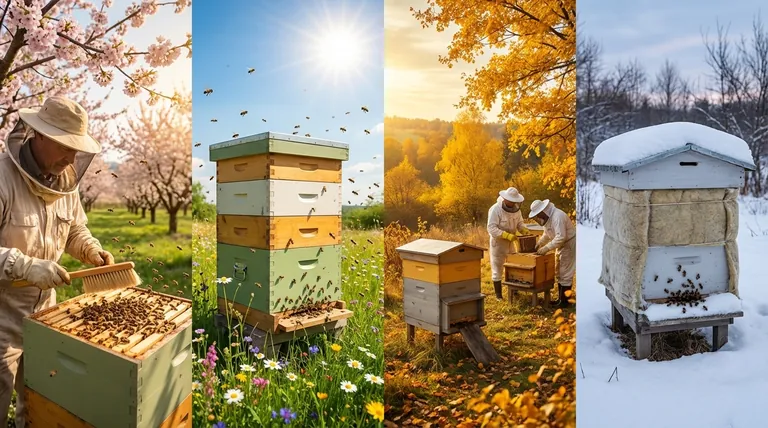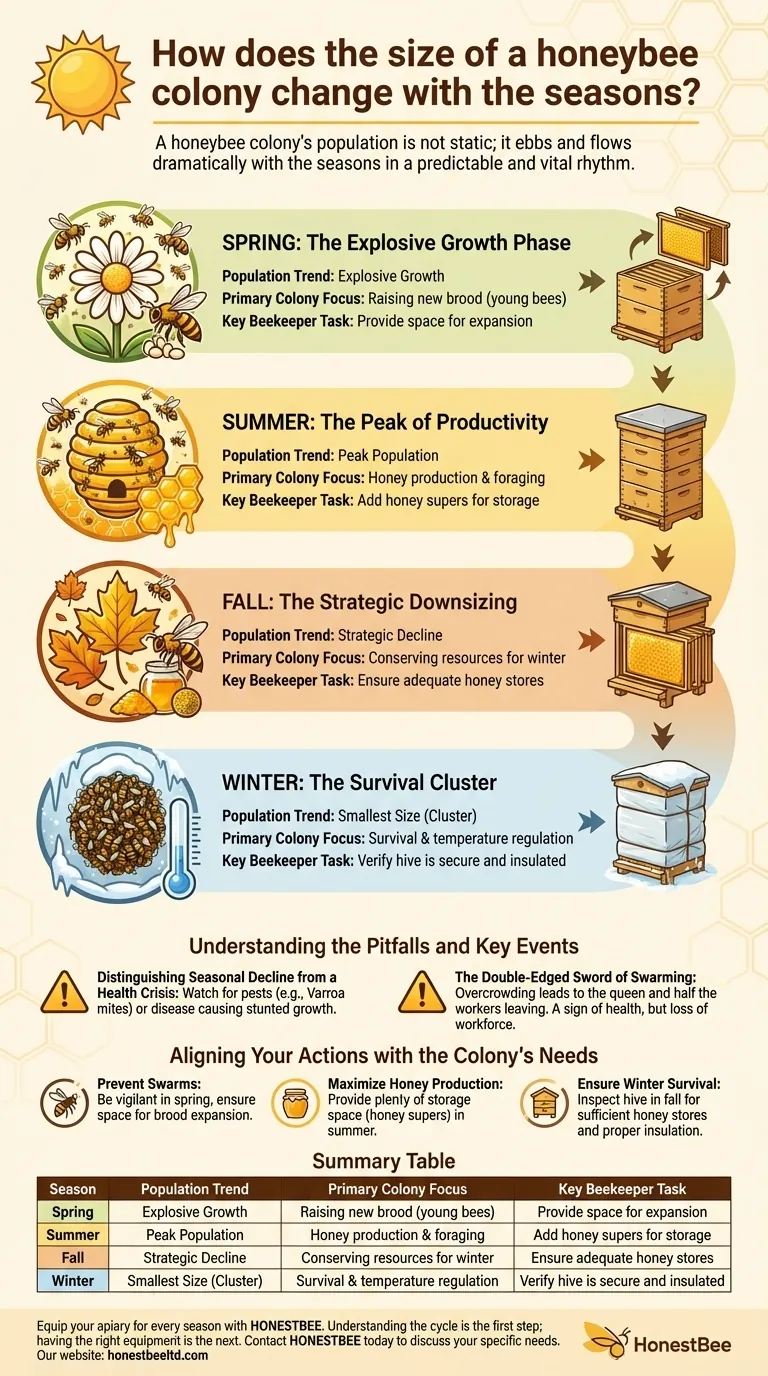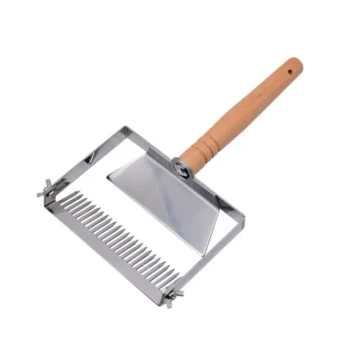A honeybee colony's population is not static; it ebbs and flows dramatically with the seasons in a predictable and vital rhythm. The colony rapidly expands in the spring, reaches its maximum size during the summer nectar flow, strategically shrinks in the fall, and contracts to its smallest size for winter survival. This annual cycle is the engine that drives all colony behavior and is the single most important concept for a beekeeper to understand.
Understanding the seasonal population cycle of a honeybee colony is not just an observation; it is the fundamental basis for effective beekeeping. Each phase—from spring expansion to winter clustering—dictates specific management tasks required to ensure the colony's health, productivity, and survival.

The Four Phases of the Colony's Annual Cycle
The size of a colony is a direct response to the availability of resources and the environmental challenges of each season. By recognizing these phases, you can anticipate the colony's needs and provide support at the right time.
Spring: The Explosive Growth Phase
In spring, as temperatures rise and flowers begin to bloom, the queen dramatically increases her rate of egg-laying. This triggers an explosive growth in the bee population.
The colony's primary focus is raising a new generation of workers, known as brood. A beekeeper's main task is to ensure the colony has enough space to accommodate this rapid expansion.
Summer: The Peak of Productivity
The colony reaches its peak population in the summer, with tens of thousands of worker bees covering many frames within the hive.
With a massive workforce available, the colony’s objective shifts from growth to honey production. The bees dedicate their energy to foraging for nectar and storing it as honey, and a beekeeper may need to add additional boxes (supers) for this purpose.
Fall: The Strategic Downsizing
As days shorten and nectar sources dwindle, the colony begins a controlled population decrease. The queen slows her egg-laying, and the number of bees begins to fall.
This is not a sign of failure but a survival strategy. A smaller population requires fewer resources to sustain itself through the winter. The bees focus on storing their remaining honey and pollen to create a winter pantry.
Winter: The Survival Cluster
By winter, the colony is at its smallest size. The remaining bees form a tight winter cluster around the queen to generate heat and keep the core of the hive warm.
Their survival depends entirely on the honey they stored during the previous seasons and a well-insulated, properly ventilated hive. The bees consume their honey stores as fuel to shiver and produce the heat needed to endure the cold.
Understanding the Pitfalls and Key Events
The annual cycle is the baseline, but you must be able to distinguish normal changes from signs of trouble. Certain events are direct consequences of population dynamics and require careful management.
Distinguishing Seasonal Decline from a Health Crisis
While a population decrease in the fall is normal, a sudden or unseasonal decline in population can be a red flag.
Factors like Varroa mites, pests, or disease can stunt colony growth or cause a collapse. If your colony's growth falters in the spring or summer, it is a critical signal that intervention is needed.
The Double-Edged Sword of Swarming
Swarming is a natural part of a honeybee colony's reproductive cycle, but it presents a major management challenge. It occurs when a hive becomes overcrowded, typically during the peak growth of late spring.
The old queen leaves with more than half the worker bees to establish a new colony. While this is a sign of a strong, healthy colony, it also means an immediate loss of a significant portion of your workforce and honey-producing potential.
Aligning Your Actions with the Colony's Needs
Your role is to work with the colony's natural rhythm, not against it. Your management decisions should be dictated by the seasonal needs of the bees.
- If your primary focus is preventing swarms: Be vigilant in spring, ensuring the colony has ample space for brood expansion and monitoring for the creation of swarm cells.
- If your primary focus is maximizing honey production: Provide plenty of storage space (honey supers) during the summer to capitalize on the peak workforce and nectar flow.
- If your primary focus is ensuring winter survival: Inspect the hive in the fall to confirm the bees have sufficient honey stores and that the hive is secure and properly ventilated for the cold months ahead.
By anticipating these seasonal shifts, you move from simply keeping bees to truly guiding them toward success.
Summary Table:
| Season | Population Trend | Primary Colony Focus | Key Beekeeper Task |
|---|---|---|---|
| Spring | Explosive Growth | Raising new brood (young bees) | Provide space for expansion |
| Summer | Peak Population | Honey production & foraging | Add honey supers for storage |
| Fall | Strategic Decline | Conserving resources for winter | Ensure adequate honey stores |
| Winter | Smallest Size (Cluster) | Survival & temperature regulation | Verify hive is secure and insulated |
Equip your apiary for every season with HONESTBEE.
Understanding the colony's annual cycle is the first step; having the right equipment is the next. Whether you manage a commercial apiary or are a beekeeping equipment distributor, our wholesale-focused operations provide the durable supplies you need to support your colonies through each critical phase—from spring expansion boxes to winter insulation kits.
Let's build a stronger, more productive beekeeping operation together.
Contact HONESTBEE today to discuss your specific needs and explore our full catalog of beekeeping supplies and equipment.
Visual Guide

Related Products
- Wooden Bee Brush with Triple Row Artificial Fiber for Beekeeping
- Heavy-Duty T-Style Frame Perch
- Stainless Steel Double Sided Honey Uncapping Fork with Scraper
- Extra Wide Stainless Steel Honey Uncapping Fork with Scraper Beekeeping Tool
- Electric Flatting and Embossing Machine with Tray for Beekeeping
People Also Ask
- What is the purpose of a bee brush? Gently Manage Your Hive with Precision
- Is a bee brush used to harm bees? Learn the Proper Tool for Gentle Beekeeping
- How does using a bee brush benefit beekeepers and the hive? Achieve Gentle, Stress-Free Hive Management
- What are the characteristics of the bristles on a bee brush? Designed for Gentle Persuasion, Not Force
- What is the purpose of a bee brush? Master Gentle Hive Management for Healthier Bees



















